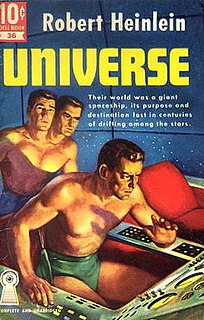Plot
Humanity is spreading rapidly through the galaxy, and a planet known as Glade has been identified as suitable for colonization as it has a near-Earth climate (and presumably near-Earth gravity and atmosphere). A colonisation expedition lands on Glade; one rocket contains the potential colonists and their equipment, whilst a second rocket returns to Earth to confirm the suitability of the planet and bring more settlers.
Under the energetic leadership of Executive Hafner, the colonists start to assemble agricultural equipment and prepare for planting fast-growing crops that they will need to survive. But biologist Dano Marin is already concerned that all is not as it should be. Biological controls have previously surveyed the planet, without actually landing, and cleared it as being benign, but very soon mice appear and attack the crops and food stocks. Attempts are made to control them, but they then appear in plague proportions.
Marin thinks he knows what has happened. The apparently harmless native lifeform, which he dubs the 'omnimal', has the ability to adapt to threats as they appear. They can mutate and reproduce with amazing speed. As the mice are brought under control by robot cats, they are replaced with rats who attack one of the cats en masse and manage to destroy it. The humans bring in terriers to fight the rats, but this only stops them temporarily. They are then further replaced by tiger-like creatures.
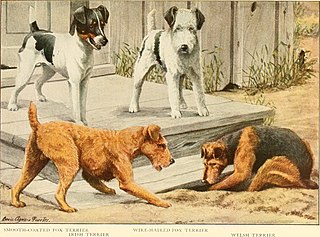
Terrier is a type of dog originally created to hunt vermin. A terrier is a dog of any one of many breeds or landraces of the terrier type group, which are typically small, wiry, game and fearless. Terrier breeds vary greatly in size from just 1 kg (2 lb) to over 32 kg (70 lb) and are usually categorized by size or function. There are five different groups, with each group having several different breeds.
Marin now knows what the next mutation will be and is proved right when food again goes missing from the fields. With Hafner only partially convinced, he seeks out the new creature. Hafner wants to shoot it, but Marin convinces him not to, knowing that a further mutated creature will be unstoppable. They come face-to-face with the creature and the story ends with the line: "It looked very much like a man."
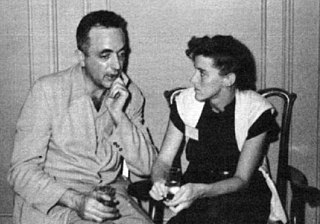
Katherine Anne MacLean was an American science fiction author best known for her short fiction of the 1950s which examined the impact of technological advances on individuals and society.
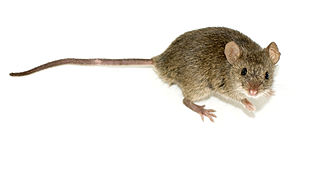
A mouse, plural mice, is a small rodent characteristically having a pointed snout, small rounded ears, a body-length scaly tail, and a high breeding rate. The best known mouse species is the common house mouse. It is also a popular pet. In some places, certain kinds of field mice are locally common. They are known to invade homes for food and shelter.

The Three Stigmata of Palmer Eldritch is a 1965 science fiction novel by Philip K. Dick. It was nominated for the Nebula Award for Best Novel in 1965.

The Martian Chronicles is a 1950 science fiction short story fixup by Ray Bradbury that chronicles the colonization of Mars by humans fleeing from a troubled and eventually atomically devastated Earth, and the conflict between aboriginal Martians and the new colonists. The book lies somewhere in between a short story collection and an episodic novel, containing stories Bradbury originally published in the late 1940s in science fiction magazines. The stories were loosely woven together with a series of short, interstitial vignettes for publication.
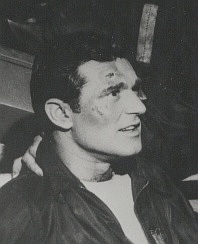
"People Are Alike All Over" is episode 25 of the American television anthology series The Twilight Zone.

Heteromyidae is a family of rodents consisting of kangaroo rats, kangaroo mice, pocket mice and spiny pocket mice. Most heteromyids live in complex burrows within the deserts and grasslands of western North America, though species within the genus Heteromys are also found in forests and their range extends down as far as northern South America. They feed mostly on seeds and other plant parts, which they carry in their fur-lined cheek pouches to their burrows.

Perognathinae is a subfamily of rodents consisting of two genera of pocket mice. Most perognathines live in complex burrows within the deserts and grasslands of western North America, They feed mostly on seeds and other plant parts, which they carry in their fur-lined cheek pouches to their burrows.

World of Ptavvs is a science fiction novel by American writer Larry Niven, first published in 1966 and set in his Known Space universe. It was Niven's first published novel and is based on a 1965 short story of the same name.
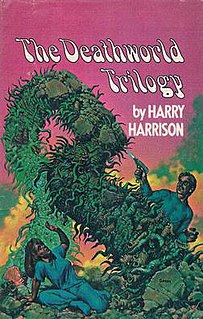
Deathworld is the name of a series of science fiction novels by American writer Harry Harrison, including the books Deathworld, Deathworld 2 and Deathworld 3, plus the short story "The Mothballed Spaceship". The central hero is a gambler who becomes involved with colonists of an extremely hostile planet.

The planet Neptune has been used as a reference and setting in various films and works of fiction:

The Body Snatchers is a 1955 science fiction novel by American writer Jack Finney, originally serialized in Colliers Magazine in 1954, which describes real-life Mill Valley, California being invaded by seeds that have drifted to Earth from space. The seeds, grown from plantlike pods, replace sleeping people with perfect physical duplicates with all the same knowledge, memories, scars, etc. but are incapable of human emotion or feeling. The human victims disappear forever.

The Collected Stories of Vernor Vinge is a collection of science fiction short stories by American writer Vernor Vinge. The stories were first published from 1966 to 2001, and the book contains all of Vinge's published short stories from that period except "True Names" and "Grimm's Story".

Groot is a fictional character appearing in American comic books published by Marvel Comics. Created by Stan Lee, Larry Lieber and Jack Kirby, the character first appeared in Tales to Astonish #13. An extraterrestrial, sentient tree-like creature, the original Groot first appeared as an invader that intended to capture humans for experimentation.
The races and Species of The Saga of Seven Suns are the assortment of humans and aliens represented in The Saga of Seven Suns series of science fiction novels written by Kevin J. Anderson and its sequel trilogy The Saga of Shadows.
In science fiction, a Jovian is an inhabitant of the planet Jupiter.

"Mars Is Heaven!" is a science fiction short story by American writer Ray Bradbury, originally published in 1948 in Planet Stories. "Mars Is Heaven!" was among the stories selected in 1970 by the Science Fiction Writers of America as one of the best science fiction short stories published before the creation of the Nebula Awards. As such, it was published in The Science Fiction Hall of Fame Volume One, 1929–1964. It also appears as the sixth chapter of The Martian Chronicles, retitled "The Third Expedition".
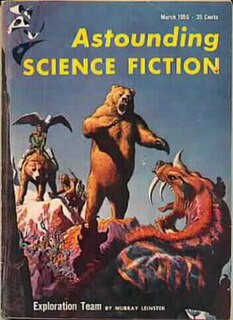
"Exploration Team" is a science fiction novelette by American writer Murray Leinster, originally published in the March 1956 issue of Astounding Science Fiction. It won the Hugo Award for Best Novelette in 1956.
"Surface Tension" is a science fiction short story by American writer James Blish, originally published in the August 1952 of Galaxy Science Fiction. As collected in Blish's The Seedling Stars, it was revised to incorporate material from his earlier story "Sunken Universe", published in Super Science Stories in 1942.

Dead Space: Downfall is an American animated science fiction horror film developed by Film Roman and Electronic Arts. It is a prequel to the video game Dead Space and takes place during the events of Dead Space: Extraction, while the Necromorphs invade the USG Ishimura after it receives the Marker. The film was released on DVD and Blu-ray on October 28, 2008 and broadcast on the Syfy Channel on December 2, 2008.


